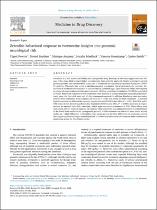| dc.contributor.author | Powrie, Yigael | |
| dc.contributor.author | Strydom, Morné | |
| dc.contributor.author | Aucamp, Marique | |
| dc.date.accessioned | 2022-08-30T08:29:53Z | |
| dc.date.available | 2022-08-30T08:29:53Z | |
| dc.date.issued | 2022 | |
| dc.identifier.citation | Powrie, Y. et al. (2022). Zebrafish behavioral response to ivermectin: Insights into potential neurological risk. Medicine in Drug Discovery, 16, 100141. https://doi.org/10.1016/j.medidd.2022.100141 | en_US |
| dc.identifier.issn | 2590-0986 | |
| dc.identifier.uri | https://doi.org/10.1016/j.medidd.2022.100141 | |
| dc.identifier.uri | http://hdl.handle.net/10566/7777 | |
| dc.description.abstract | Ivermectin is a well‐known and widely used anti‐parasitic drug. Recently, in vitro data suggest anti‐viral effi-
cacy of the drug, albeit at much higher concentrations than currently approved. Despite warnings by several
governing bodies, the (uncontrolled) human use of ivermectin has significantly increased during the COVID‐
19 epidemic. This study thus aimed to elucidate potential neurological risk of particularly the veterinary for-
mulation of ivermectin in comparison to pure ivermectin. Zebrafish eggs (1hpf) and larvae (4dpf) were exposed
to a range of concentrations of either pure ivermectin (IVM) or a veterinary formulation (V‐IVM) for a period of
24 hours. Behavioral responses to both treatments were assessed at various timepoints using the pentylenete-
trazol assay, the light–dark assay and a 5‐day teratogenesis protocol. In addition, dissolution rates were calcu-
lated for both treatments. | en_US |
| dc.language.iso | en | en_US |
| dc.publisher | Elsevier | en_US |
| dc.subject | Covid-19 | en_US |
| dc.subject | Veterinary formulation | en_US |
| dc.subject | Neurological risk | en_US |
| dc.subject | SARS‐CoV‐2 | en_US |
| dc.subject | Zebrafish | en_US |
| dc.title | Zebrafish behavioral response to ivermectin: Insights into potential neurological risk | en_US |
| dc.type | Article | en_US |

